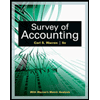
Statement of
Direct method: This method uses the basis of cash for preparing the cash flows statement.
Cash flows from operating activities: In this direct method, cash flow from operating activities is computed by using all cash receipts and cash payments during the year.
Cash Receipts: It encompasses all the cash receipts from sale of goods and on
Cash Payments: It encompasses all the cash payments that are made to suppliers of goods and all expenses that are paid.
The below table shows the way of calculation of cash flows from operating activities:
| Cash flows from operating activities (Direct method) |
| Add: Cash receipts. |
| Cash receipt from customer |
| Less: Cash payments: |
| To supplier |
| For operating expenses |
| Income tax expenses |
| Net cash provided from or used by operating activities |
To Determine: The amount of cash paid for merchandise.
Want to see the full answer?
Check out a sample textbook solution
Chapter 14 Solutions
CENGAGENOWV2 FOR WARREN'S FINANCIAL & M
- Jatka Corporation estimates the overhead costs for the next year will be $7,650,000 for indirect labor and $295,800 for factory utilities. The company uses machine hours as its overhead allocation base. If 475,000 machine hours are planned for the next year, what is the company's plantwide overhead rate? (Round to two decimal places.) a. $0.06 per machine hour b. $16.73 per machine hour c. $14.21 per machine hour d. $0.64 per machine hourarrow_forwardFinancial accountingarrow_forwardAccurate Answerarrow_forward
- I need help with this general accounting problem using proper accounting guidelines.arrow_forwardCan you explain the process for solving this financial accounting question accurately?arrow_forwardI am looking for the correct answer to this financial accounting question with appropriate explanations.arrow_forward
 College Accounting, Chapters 1-27AccountingISBN:9781337794756Author:HEINTZ, James A.Publisher:Cengage Learning,
College Accounting, Chapters 1-27AccountingISBN:9781337794756Author:HEINTZ, James A.Publisher:Cengage Learning, Managerial AccountingAccountingISBN:9781337912020Author:Carl Warren, Ph.d. Cma William B. TaylerPublisher:South-Western College Pub
Managerial AccountingAccountingISBN:9781337912020Author:Carl Warren, Ph.d. Cma William B. TaylerPublisher:South-Western College Pub Managerial Accounting: The Cornerstone of Busines...AccountingISBN:9781337115773Author:Maryanne M. Mowen, Don R. Hansen, Dan L. HeitgerPublisher:Cengage Learning
Managerial Accounting: The Cornerstone of Busines...AccountingISBN:9781337115773Author:Maryanne M. Mowen, Don R. Hansen, Dan L. HeitgerPublisher:Cengage Learning Survey of Accounting (Accounting I)AccountingISBN:9781305961883Author:Carl WarrenPublisher:Cengage Learning
Survey of Accounting (Accounting I)AccountingISBN:9781305961883Author:Carl WarrenPublisher:Cengage Learning Cornerstones of Financial AccountingAccountingISBN:9781337690881Author:Jay Rich, Jeff JonesPublisher:Cengage Learning
Cornerstones of Financial AccountingAccountingISBN:9781337690881Author:Jay Rich, Jeff JonesPublisher:Cengage Learning Financial Accounting: The Impact on Decision Make...AccountingISBN:9781305654174Author:Gary A. Porter, Curtis L. NortonPublisher:Cengage Learning
Financial Accounting: The Impact on Decision Make...AccountingISBN:9781305654174Author:Gary A. Porter, Curtis L. NortonPublisher:Cengage Learning





